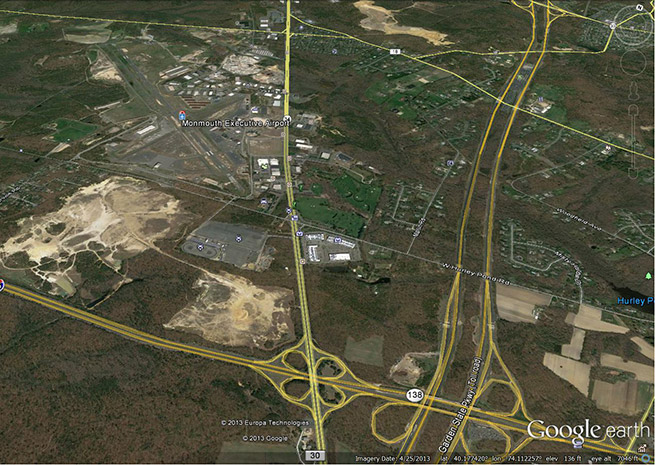
The airport’s Wall Township, N.J., location has a lot going for it: nearly 700 acres in a densely populated area, just outside of the Newark Class B airspace and a little more than an hour’s drive from Manhattan. Even with a more than 7,000-foot-long runway, jet aviation has never been encouraged at Monmouth Executive Airport.
That has already begun to change.
The new owners had to wait more than a decade to close the deal, but close they have—and they will waste no time sprucing up the place.
“We’re literally going to do everything,” said Richard Asper, chairman of Aviation Professionals Group, the Florida firm whose clients—the new owners—have long sought the a private airport with Monmouth’s potential and qualities. Asper said that with various regulatory and other hurdles now cleared, “this airport will be unrecognizable from its present form in weeks.”
With a runway that is more than 300 feet longer than the main runways at New York’s La Guardia, and plenty of vacant hangar space, the new owners—Wall Aviation LLC—plan to attract business jets in particular. The FBO, reopened Nov. 22 with a new name, Monmouth Jet Center, reflects the shift in emphasis. A hangar with more than 100,000 square feet of floor space will no longer be used to store trash dumpsters, for another thing. It is among the largest privately owned airports capable of serving jets (with a 7,371-foot runway), and the new owners are pursuing a decidedly different relationship with federal agencies. That is to say, they are pursuing relationships that the former owner steadfastly resisted, to the point of not returning calls from the federal government.
Monmouth Executive, once known as Allaire Airport, was built in the last days of World War II by the late Ed Brown, who bulldozed his own runways and steadfastly refused federal help. Brown never sought designation as a reliever airport (the FAA applied that designation unilaterally) or federal airport improvement funds, Asper said: “He simply didn’t want to participate in that scheme.”
Installation of pilot-controlled lighting is among the first changes planned, a departure from the protocol followed for years that effectively made the airport a daylight-only option for many operators. “You had to call the airport manager an hour ahead and hope he could get to the switch,” Asper said.
The sale price was not disclosed under confidentiality agreements, though the airport had been valued in the upper end of the $40 million range in years past, Asper noted. Years of delays attributable to local politics, Brown’s tenacious obstinacy, and designation as a Superfund site by the U.S. Environmental Protection Agency all delayed the sale. Local press reported the new owners will pay the EPA $21.5 million to cover the cost of cleanup already completed, and ongoing monitoring. Asper said an electronic copy of the EPA’s approval is already in the new ownership’s hands. As soon as the hard copy arrives, little time will be wasted opening dialogue with and presenting plans to other state and federal agencies.
“You can bet that we’re going to have communications with the FAA very quickly,” Asper said. He declined to specify planned projects before presenting them to FAA officials, though he said much of the early focus will be on “making things look nice,” with renovated amenities including an “attractive and useable” pilot lounge.
A new website is up and running, the leading edge of an effort to market the airport to jet owners seeking a more efficient option for travel to and from metropolitan New York and New Jersey. Asper said the airport is only about 15 minutes farther away by car from Manhattan than Teterboro (drive times vary), and IFR clearances can be obtained much more quickly because of the airport’s location just south of the highly congested airspace. Instead of waiting an hour or more, flight crews can typically call for clearance just before taxiing and receive it before reaching the departure end of the runway, Asper said. “They don’t even come to a stop.”
Asper said the previous owners—Brown, followed by a family trust that continued the tradition of aggressive avoidance of government cooperation or communication—made no effort to rent space in the massive hangars, which helps explain why so much space is still available in the midst of so much pent-up demand. Optimism is running high that the vacant space will be snapped up fast.
With Super Bowl XLVIII to be played in East Rutherford, N.J., on Feb. 2, Asper said the new owners are working to resolve all remaining tax and regulatory issues and get cracking on the cosmetic improvements, hoping to welcome the football crowd.
Not everyone is happy with the changes, according to the local press. Owners of skydiving and aerial advertising businesses are anxious about being forced to relocated, and told the Asbury Park Press they have limited options to set up shop elsewhere. The final dispositions remain to be settled; Asper noted that Brown had attracted an “eclectic” mix of tenants, not all of them aviation-related businesses.
“Sadly, some of the tenants have been permitted to drive onto the taxiways and runways,” Asper said. “That all stops immediately.”
Asper said Brown’s resistance to change—and federal involvement—helped preserve the airport’s potential as a destination for business jets in a sprawling metropolis. “That created this enormous opportunity,” Asper said, noting it would take decades to build such an airport from scratch, even without seeking public funding, if such a tract of land could even be found.
The new owners plan to take full advantage, while embracing FAA standards and the funding for future upgrades that may follow.



